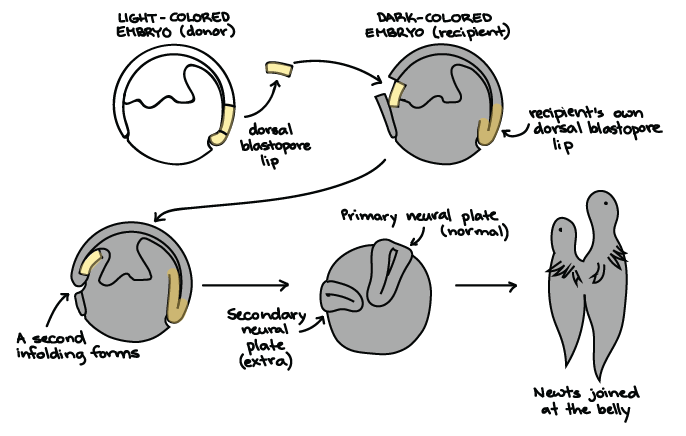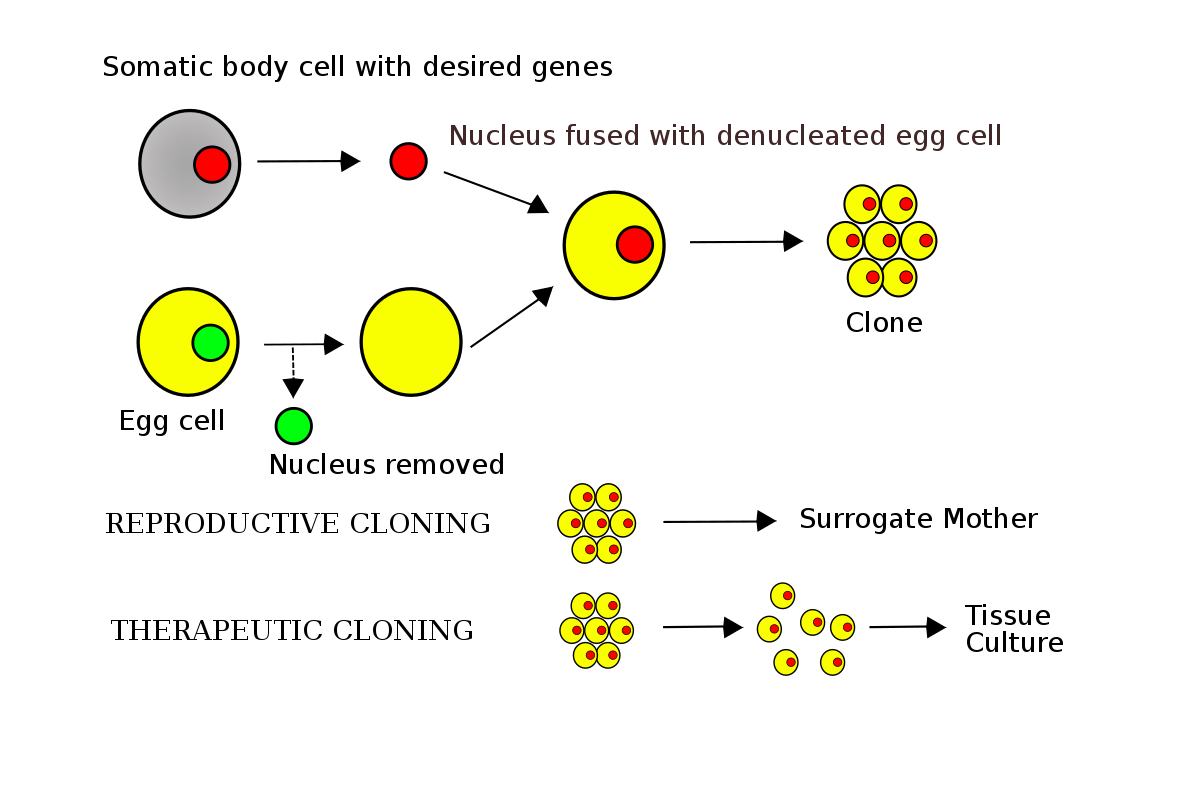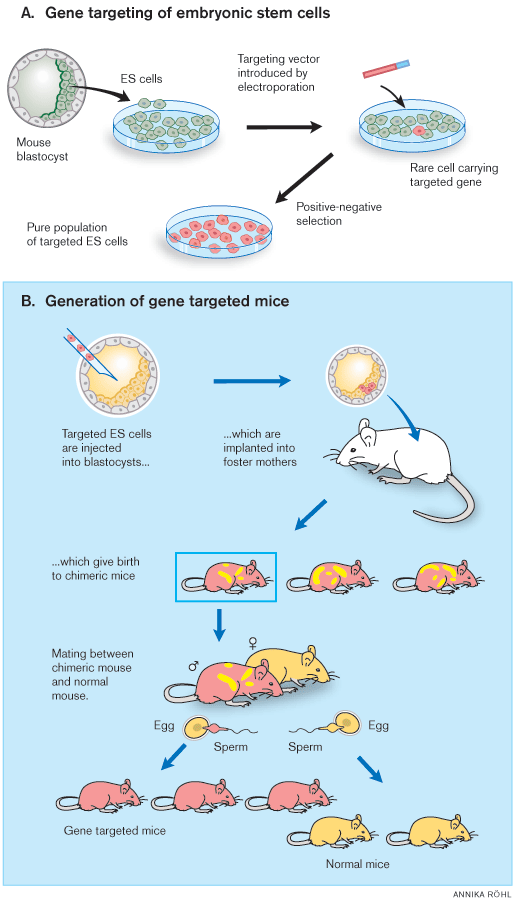General concepts in Developmental Biology and their historical context
Assignment
Introduction
- The change of common understanding of genetic material from proteins to DNA was a long ardious process.We will study some of these perspectives in the class.
Some Historical Perspective
- **Preformation: **
Epigenesis: The theory of how the seed evolves into a lively being.
Two kinds of cells (Theory of Germ Plasm):
- Germ cells: The cells that are used for reproduction. Zygote?
- Somatic cells: make the body. Mutations in the Somatic cells are not passed on to the next generation.
Pluripotency/totipotency:

The Spemann-Mangold Experiment:

The experiments at Thomas Hunt Morgan’s lab used Deosophila to show the inheritance of traits that were particularly present on the genetic material of one of the parent. They could definatively claim that the genetic encoding was present on the chromosomes using their experiments.
Somatic Cell Nuclear Transfer:

Genes control embryonic development: This was illustrated using the “Hox Genes”, where they modified a single gene, with whose modification, they were able to indice the development of many legs in Drosophila.
Zebra Fish is used as a model organism because you can see the whole embryonic development process clearly under the microscope.
Morphogens
A morphogen is a molecule that controls the formation of patterns during embryonic development through their non-unifrom distribution.


Morphogenes were identified that control the patterns during embryonic development stages.

Induction
- Two kinds of Induction
- Instructive: Tissue is told what to become.
- Permissive: Tissue knows what to become already, it wait for its trigger.
Generic Notes
Stem cells can divide forever in a culture.
Genetic Material Transfer


Cas9 and Cas13
The emerging technologies and approaches applied to the study of development
How do you know what is going on inside cells or tissues? Identification of the activity of single genes/proteins and their combination:
- Globally: Northern blot, Western blot, RT-PCR
- Spatial resolution: In situ hybridization, immunochemistry
Western Blot: Seperates proteins based on the size of their sequences. The protein is denatured and folded with sphericity using a chemical agent before placing it in the gel.
Massive Paralle Sequencing:
Capturing dynamic processes of cellular lineages:
- RNA velocity
- Compares splices and non-spliced RNA sequences
- Diffusion maps
- Searches for the nearest neighbor graphs in the transcriptomes of consecutive stages to create orderly sequences and branches
- Uses data from developmental series
- RNA velocity
Mechanisms of Morphogenesis Lab
Some Xenopus laevis discoveries and gossip
- X. laevis and X. tropicalis: The development temperatures are different. For Tropicalis, it can be controlled quite well.
- The origin of these frogs is in Africa. In the wild, they are very agressive and at many places they have become an invasive species.
XenbaseXenopusare websites that are databases for Xenopus.- How this started? : Luigi Galvani and the frog mustle experiment(s).
- Electric fields drive neural crest migration ex vivo.
The Xenopus Pregnancy Test
Inject frogs with urine sample while them swim in a sterile buffer. The sampl was injected near the overies of the femaile Xenopus.
Only effective for detection if the pregnancy was about 3-5 weeks.
Release of frog eggs would indicate a pregnancy.
Lancelot Hogben established the first Xenopus colony at the London School of Economics in 1927.
Exploited the fact that Xenopus females laid eggs in response to human chrionic gondatropin.
Down to Embroyos
The nucleus from the same species can be transplanted into an egg and it can develop to a tadpole and beyond.
‘Something’ happens later when the cells get differentiated that makes the nucleus unable to be reprogrammed.
Later in 2012, John B. Gurdon and Shinya Yamanaka got the Nobel Prize for their work in understanding ’the something’ - which today is called nuclear reprogramming.
Robert Briggs and Thomas J King did the very first nuclar transplantation in Xenopus.
Spemann-Mongold organizer
- 1924: they discovered the Spemann-Mongold organizer which is a portion of the embroyo that induces other cells to organize specifically.
The motor of morphogenesis
- Fate maps: put fluorophores in a particular locations and track where they end up during morphogenesis.
Synchronising tissue morphogenesis
- Cell migration involves active translocation of a cell or a group of cells from one position to another and it is essential in a wide range of physiological as well as pathological contexts.
Philotaxis TODO
- Warber Effect: Hypoxy in the presence of sufficient oxygen due to excessive expenditure in active transport.
Read about Lamella and substrate adhesion dependent movement. Espina JA, et al, 2021 FEBS
- Cells form blebbs to escape confinement.
- Social cells:
- Bias induces the to swim in a particular direction.
- They can cooperate and form specific structures. Within these structures they aquire specialised roles.
Read about Contact Inhibition of locomotion.
- Epithelial cells can also migrate.
- Durotaxis: Transport along a stress gradient.
Why ‘The Neural Crest?’ [for studying cell migration]
Read Cell Movement Is Guided by the Rigidity of the Substrate.
From animal caps to omics and mechanics of cell extrusion
- Amphibians were used for pioneering cell migration studies.
- Best way to cut the embroyo is from the eye lash of a new born baby.
- Xenopus leaves: First described by the French naturalist Francois Marie Daudin in 1803. The name means: the clawed African frog.
- Michail Fischbergy recognised that this [urine injection] allowed for frog embroyology to be run throughout the year.
Nuclear reprogramming experiment
- Kill the OG nucleus with high intensity UV radiation. Add the required nucleus from the somatic cells of the to-be-cloned organism.
How to work with Xenopus?
- Squeeze to release the eggs. Put the female for rest for 3 months.
- Kill the male frog, and chop the testis. Make testis soup and mix it with the eggs. The Eggs are fertilized!
Cell turnover maintains tissue formation
- Replacement of cells:
- Cell division
- Or stem cells migrate to the position and assume the role
- The balance is described as follows; an imbalance causes Cancer:
Multiciliary epithelium cells are model systems for studying a variety of mechanisms.
Apical emergence: How does a stem cell move to a specific position and assumes a specialized role?
Check how to calculate tension along on a non-uniform string.
How to make an organ: Questions of shape, growth and patterning: The example of the retina
They work on organ development in the context of the Retina. We study organogenesis in the developing zebrafish.
Light Sheet Microscopy: The FOV moves in a plane across the z-axis. The exposure is only limited to a thin slice of the sample.
Spinning Disk Microscopy: Many pinholes spin, while the smaple is exposed through these pinholes. TODO
Retenogenesis
graph LR Shape-->Growth-->Patterning Shape-.->OCF(Optical Cup Formation) OCF-.->3RG(3 Different Epithelial Rearrangements) Growth -.-> SSM(Some Steps Missing) Patterning -.-> Neuroepithelium(Neuroepithelium) -.-> ML(Migration and Lamination) -.-> Lamination(Lamination)The Optic Cup Formation shape is conserved over evolution even when neuronal composition is not.
Extra Cellular Matrix: It forms rails on which cells can move about.
Zebrafish is a good system to study optics is because the neural composition is closer to humans. Mice are nocturnal so that doesn’t work.
Neural lamination is a widespread feature of brain development. Like the Hippocampus, Neocortex, and ofcourse the retina.
RGC needs to connect with particular PRs.
Mechanics of tissue renewal, or how to get a “new gut” every week
- Classification of adult tissues:
- No renewel - no mitosis detected
- Sensory organs (retina, innear ear)
- Probably no renewal - infrequenct mitosis, leading to slow growth
- liver, kidney, endocrine and exocrine glands, connective tissues
- Rebewing tissues - abundant mitoses, exceeding the needs for adult growth
- Simple static epithelia: respiratiory epithelium
- TODO
- TODO
- TODO
- No renewel - no mitosis detected
- Fastest-renewing tissues: 96% of the total turnover
- erythocytes
- neutrophilis
- intestinal epithelia
- Renewel is not the same as regeneration after injury.
- Turnover rate approx. 3-5 days (the time taken by the cell to be born and to die).
- Small intestine: is the largest mucosal surface of the body and also the fastest-renewing epithelium in mammals (3-5 days).
- The cells in the samll intestines form in the crypt and migrate over the vilius to the extrusion part, where they form mucas and eventually die.
- The gut epithelium is a dynamic tissue barrier. You have different stresses:
- Chemicals - toxins
- Mechanical - pressure, stretch
- Biological - pathogens
- How is the balance achieved between division, migration, and extrusion ?
- The cell-division only takes place in the crypt, it cannot take place in the extrusion. Hence, small intestine cancers are extremey rare (there are many other reassons like a short lifecycle).
- By running biophysical model we can simulate the density and velocity profiles. By comparing with the experimental data, it was found that active migration was a necessary component in the dynamics of these migrating cells.
- Gut epithelium is under tension because the cell migration is pulling on the cell-cell junctions.
- Laser ablations are used to map junctional tensions.